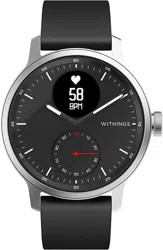Loading ...
Loading ...
Loading ...

EN-64
ScanWatch
v1.0 | August, 2020
Frequently asked questions about Atrial Fibrillation (AFib)
What is Atrial Fibrillation (AFib)?
An arrhythmia is an anomaly of this electrical activity. In particular, atrial
fibrillation is caused by a disorganized firing of electrical impulses in the right
atrium near the sinoatrial node, the natural pacemaker of the heart, where it is
located.
Atrial fibrillation is the most common cardiac arrhythmia and is one of the leading
causes of stroke, heart failure, and cardiovascular morbidity in the world. It may
be symptomatic (palpitations) or —more often—asymptomatic. In this case, it can
remain “silent” which is why earlier detection of the disease could enable better
care and help to avoid complications.
Silent, undetected AFib is common, with severe consequences such as stroke and
death. Prompt recording of an ECG is an eective and cost-eective method to
document chronic forms of AFib. The specificity of atrial fibrillation is that it can
be assessed from any lead of an ECG.
How is Atrial Fibrillation (AFib) diagnosed today?
The gold standard for the diagnosis of AFib is the electrocardiogram. Recent
recommendations encourage early detection of AFib via an ECG. Several studies
report an interest in systematically screening at-risk populations by performing an
ECG.
Until recently, the diagnosis of AFib required an ECG recorded in the doctor’s
oce. Therefore the “diagnostic window” for AFib detection was restricted to the
duration of the medical consultation.
How isAtrial Fibrillation (AFib) detected?
A cardiologist looks at 3 items to diagnose AFib with an ECG :
• Absence of the P wave in front of the QRS complexes
• The rhythm of the QRS complexes (irregular and generally rapid heart rate,
with generally narrow QRS complexes)
• The baseline shows a tremor (due to untimely activation of the atria). Our
machine learning algorithm classifies ECG signals by analyzing both the QRS
rhythm and the shape of the heart waves
What is the prevalence ofAtrial Fibrillation (AFib)?
Atrial fibrillation is aecting nearly 3% of the adult population in Europe, and
responsible for almost a third of the strokes in developed countries. 2.7M of the
US population has AFib, among them, 9% of people are over 65 years old.
The prevalence is growing rapidly from 60 years old. It is aecting 0.12 - 0.16% of
the population under 50, 3.7-4.2% of the 60-70-year-old, and 10 to 17% of people
over 80 years old.
Loading ...
Loading ...
Loading ...
